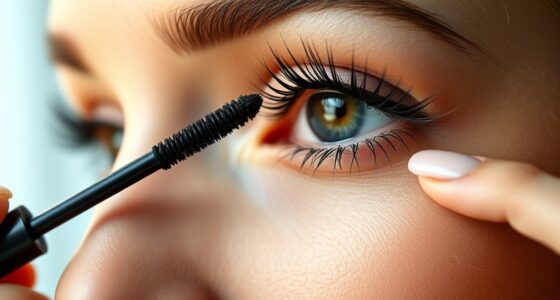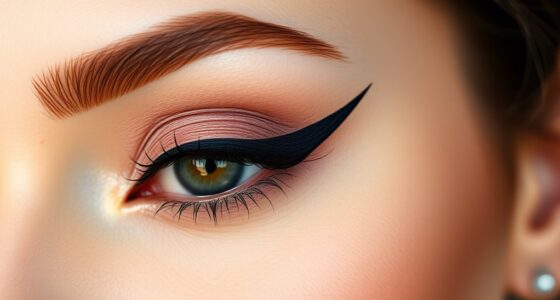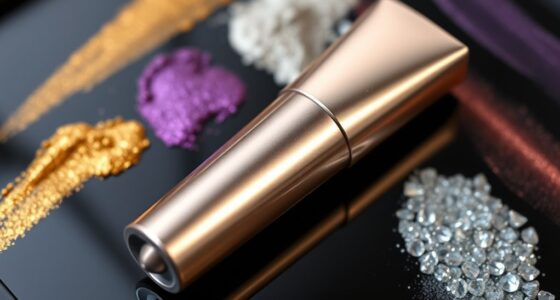Expensive foundations often perform worse because higher prices don’t mean better ingredients or formulation quality. Luxury brands spend more on packaging and marketing, inflating costs without improving the product itself. Many high-end foundations share similar ingredients with drugstore options, and formulations may have shorter shelf lives or feel heavy on the skin. Personal sensitivities also play a role—sometimes, budget picks can outperform in both wear and skin tolerance. Keep exploring to discover more about these surprising truths.
Key Takeaways
- Higher price doesn’t guarantee better ingredients; luxury foundations often share similar core components with drugstore options.
- Expensive brands invest heavily in packaging and marketing, inflating costs without improving formulation quality.
- Complex formulations in luxury foundations can reduce shelf life and negatively impact texture and finish.
- Luxury products may contain irritants like fragrance or heavy preservatives, causing skin sensitivities.
- Drugstore foundations often contain high-quality active ingredients and offer better performance at lower costs.
The Myth That Higher Price Guarantees Better Formulation
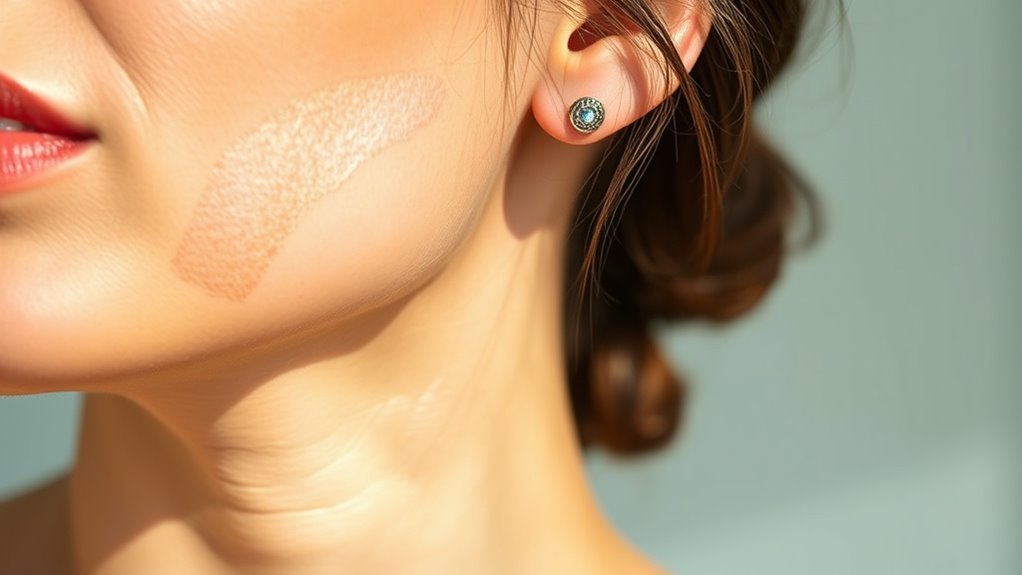
Many people assume that paying more for a foundation means you’ll get a better formula, but that’s often a misconception. Brand name products and expensive high-end foundations are frequently priced higher because of branding, packaging, and marketing costs, not necessarily superior ingredients or formulation. Studies show that drugstore foundations often contain similar active ingredients—like silicones and pigments—as their costly counterparts. Some luxury brands even add unnecessary filler ingredients that don’t improve performance, sometimes making the product worse. Higher prices can create inflated expectations, but they don’t guarantee better wear, coverage, or skin compatibility. In fact, many affordable drugstore options deliver comparable, if not better, results because they focus on effective formulations without excessive markups. Glycolic acid is an example of an ingredient that can be found in both high-end and drugstore skincare products, highlighting how formulation quality isn’t solely determined by price. Additionally, formulation transparency varies widely and isn’t always correlated with price, so consumers should evaluate ingredients rather than relying solely on brand prestige. Recognizing that product formulation can be similar across price ranges and that expensive foundations may include unnecessary additives empowers consumers to make more informed choices and avoid unnecessary spending. Moreover, understanding the role of ingredient quality can help consumers discern between products that truly deliver benefits and those that are overpriced for branding alone.
Packaging and Branding Costs Inflating the Price
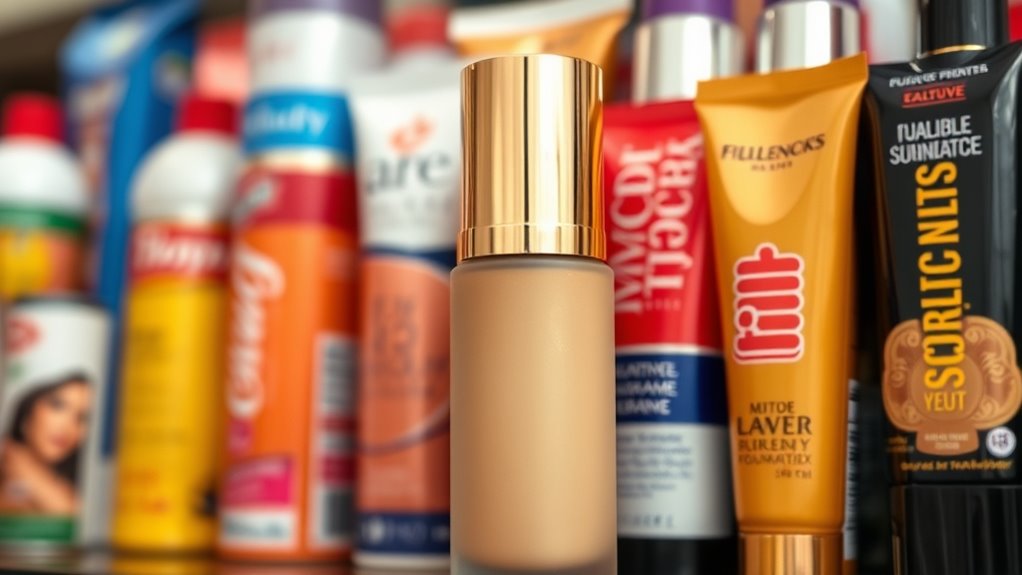
While ingredient quality often gets the spotlight, the true driver behind many high-end foundation prices lies in packaging and branding. These elements can account for up to 40% of the retail cost, inflating prices without improving the formula. Luxury brands pour money into designer-like packaging, elaborate boxes, and limited-edition bottles that boost production costs and consumer prices. Marketing, celebrity endorsements, and the visual appeal of packaging considerably influence the perceived value, often overshadowing actual product performance. Many expensive foundations feature intricate designs, luxe materials, and decorative details that enhance presentation but add little to no benefit to how the foundation works on your skin. Additionally, the high costs associated with branding and marketing strategies often drive prices higher, regardless of the product’s efficacy. This focus on luxury branding often leads consumers to believe they are purchasing a superior product when, in many cases, they are paying mainly for the visual appeal and status. In fact, the emphasis on prestige marketing can overshadow the importance of product quality and results. Moreover, consumers are often influenced by marketing tactics that emphasize exclusivity and luxury over actual ingredient benefits. Consumers may also be misled by luxury packaging, which can give an illusion of higher quality without delivering better results. Ultimately, you’re paying more for presentation and prestige rather than a superior or more effective foundation formula.
Ingredient Similarities Between Luxury and Drugstore Foundations
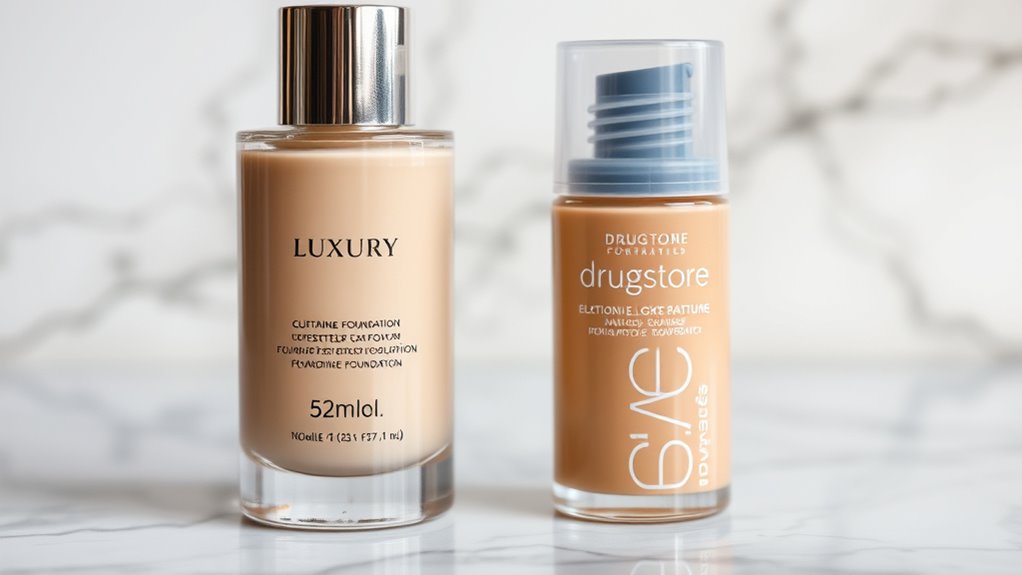
Despite the reputation of luxury foundations as superior, their core ingredients often mirror those found in drugstore brands. Both types of formulations commonly include ingredients like water, silicones, and emollients, making them quite similar. The main difference lies in the concentration or refinement of active ingredients, but this doesn’t always lead to better results. Many ingredients, such as pigments and fillers, are sourced from the same suppliers, resulting in comparable color payoff and coverage. The perceived quality of expensive foundations is often driven by packaging and branding rather than true ingredient differences. Additionally, formulation similarities show that both tiers frequently utilize the same base components, emphasizing that price does not necessarily equate to potency or effectiveness. Industry standards and manufacturing processes also play a role in standardizing many common ingredients across different brands. Interestingly, product formulation can also be influenced by industry standards and manufacturing processes that standardize many common ingredients across different brands. Moreover, the consistency in ingredient sourcing and formulation practices highlights how ingredient sourcing impacts the final product quality and price point. Below is a visual comparison of the formulation similarities:
| Ingredient Type | Luxury Formulation | Drugstore Formulation |
|---|---|---|
| Water | Yes | Yes |
| Silicones | Common | Common |
| Emollients | Similar | Similar |
| Pigments | Sourced similarly | Sourced similarly |
How Marketing Influences Perceived Quality and Effectiveness
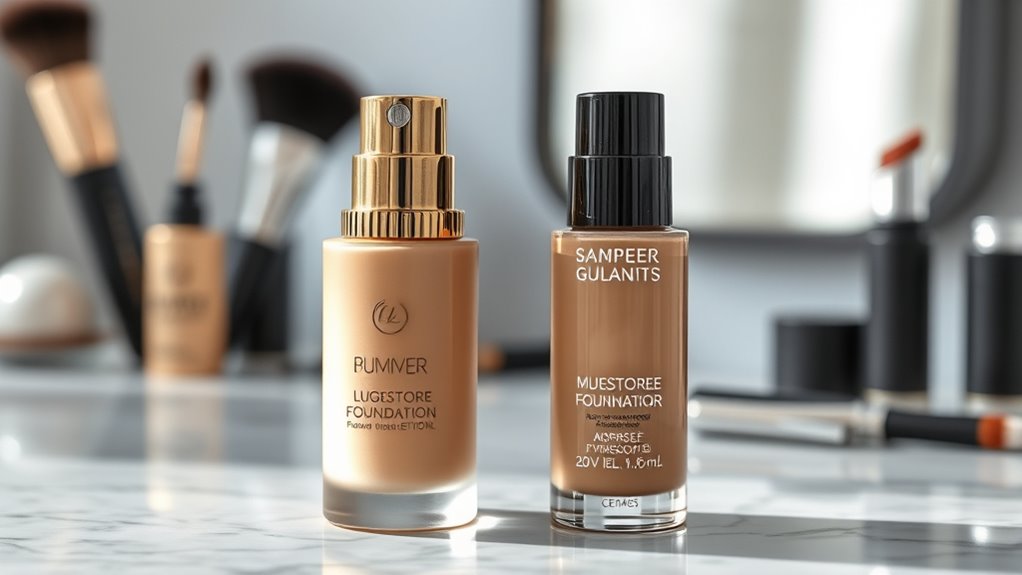
Marketing plays a powerful role in shaping how you perceive the quality and effectiveness of foundations, often regardless of their actual performance. It creates illusions that influence your perception through tactics like glossy ads, celebrity endorsements, and luxury packaging. Brands emphasize rare or exotic ingredients to justify higher prices, even if they don’t improve efficacy. They also rely on aspirational branding that links their products to status and beauty ideals, making you believe they’re more effective than drugstore options. Studies show that expectations of luxury can boost your subjective experience—a placebo effect. Additionally, marketing highlights exclusivity, innovation, and prestige, which can overshadow objective factors like formulation or longevity. These strategies manipulate perception, often leading you to favor expensive foundations despite similar or inferior performance. Recognizing how perceived value influences consumer choices can further clarify why expensive products sometimes underperform. Understanding marketing tactics that leverage emotional appeals and social proof can help you see beyond the surface and make more informed decisions. Moreover, the influence of advertising strategies extends into shaping your overall expectations even before trying the product.
The Role of Skin Compatibility and Personal Preferences
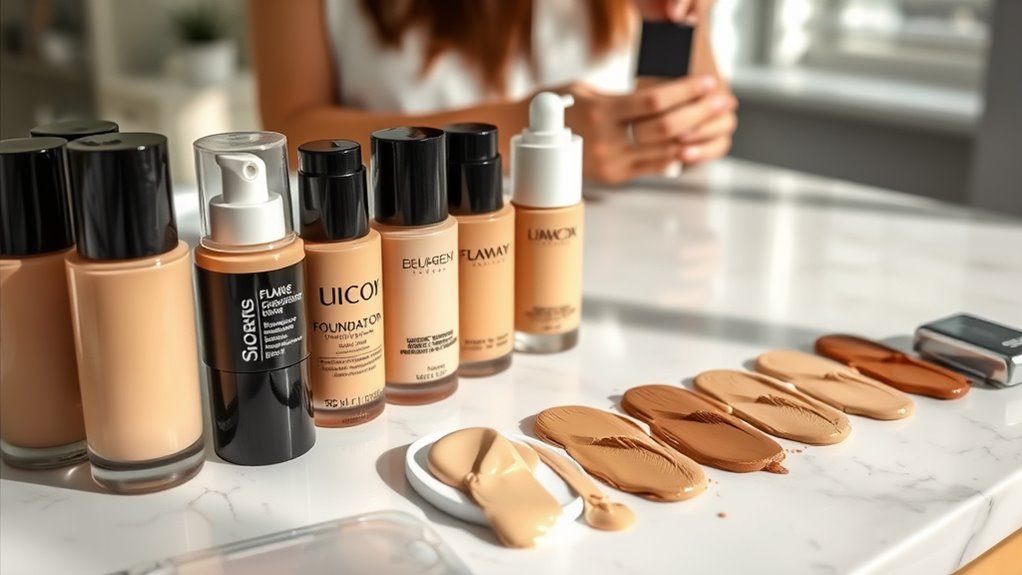
Your skin’s unique chemistry and sensitivities can greatly influence how a foundation performs, often more than its price or brand reputation. Skin compatibility is key—some expensive foundations contain ingredients that may irritate sensitive skin, causing breakouts or discomfort. Conversely, many drugstore foundations use simple, well-tolerated ingredients like glycerin and silica, which can better suit certain skin types and preferences. The finish and wear of a foundation depend heavily on your individual skin chemistry, meaning a less costly product might outperform a pricier one for you. Personal preferences, such as texture, coverage, and finish, often matter more than brand prestige. Testing different formulations and choosing what works best for your skin’s needs is the most suitable way to achieve optimal results. Additionally, understanding textile art techniques can help you select products that enhance your skin’s natural texture and appearance. Recognizing skin sensitivities can guide you toward formulations that minimize irritation and improve overall satisfaction.
Active Ingredients: Do Expensive Foundations Deliver More?
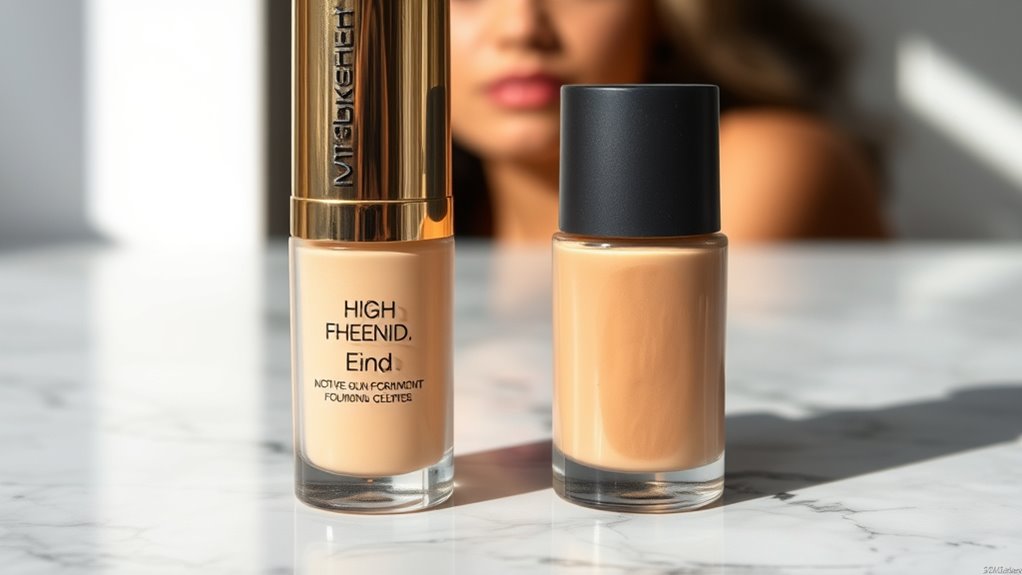
Many assume that expensive foundations deliver more active skin-beneficial ingredients, but this isn’t always the case. When it comes to active ingredients, higher price tags don’t guarantee better results. In fact, many formulations contain similar active ingredients like silicones, fillers, and pigments as drugstore brands. The concentration of key actives—such as antioxidants or SPF—is often comparable or even lower in luxury products. Luxury packaging and branding tend to be the main focus rather than boosting active ingredient potency.
- Active ingredients like hyaluronic acid or niacinamide depend on formulation stability and concentration, not just cost.
- Higher-priced foundations often emphasize aesthetics over formulation quality.
- The formulation’s design affects how well active ingredients work, regardless of price.
- Cheaper brands can sometimes deliver more effective active ingredients through better formulation.
Formulation Stability and Shelf Life in Costlier Products

While luxury foundations often feature complex formulations with delicate ingredients, this complexity can actually shorten their shelf life. The inclusion of natural extracts and specialized components makes formulation stability more difficult to maintain over time. These ingredients are prone to degradation when exposed to light, heat, or air, which compromises the product’s effectiveness. Additionally, many high-end brands opt for fewer preservatives to appeal to consumers seeking cleaner formulas, further reducing shelf life. As a result, luxury foundations tend to have a shelf life of around 6-12 months, compared to drugstore options that often remain stable for 12-24 months due to simpler, more stable formulations. This reduced shelf life can lead to decreased performance and potential skin irritation over time.
The Impact of Texture and Finish on Performance

Texture and finish play essential roles in how foundations perform throughout the day. Expensive foundations often have thicker, more emollient textures that can feel heavy or greasy, which hampers their natural finish. They may also emphasize fine lines or pores, making the skin look less smooth. The finish itself is fundamental—many high-end options aim for a dewy or luminous look, but this can turn oily or streaky over time, reducing longevity. Conversely, drugstore foundations typically use lighter, more buildable textures that blend easily and set for a matte or natural finish. The formulation of luxury foundations can cause patchiness or uneven application if the texture isn’t well-matched to your skin type. Here’s how texture and finish influence performance:
- Heavier textures can feel greasy and impair a natural look
- Dewy finishes may appear oily and streaky over time
- Texture inconsistencies can cause patchiness and unevenness
- Finish quality impacts how fine lines and pores are emphasized
Potential Irritants and Sensitivities in Premium Foundations
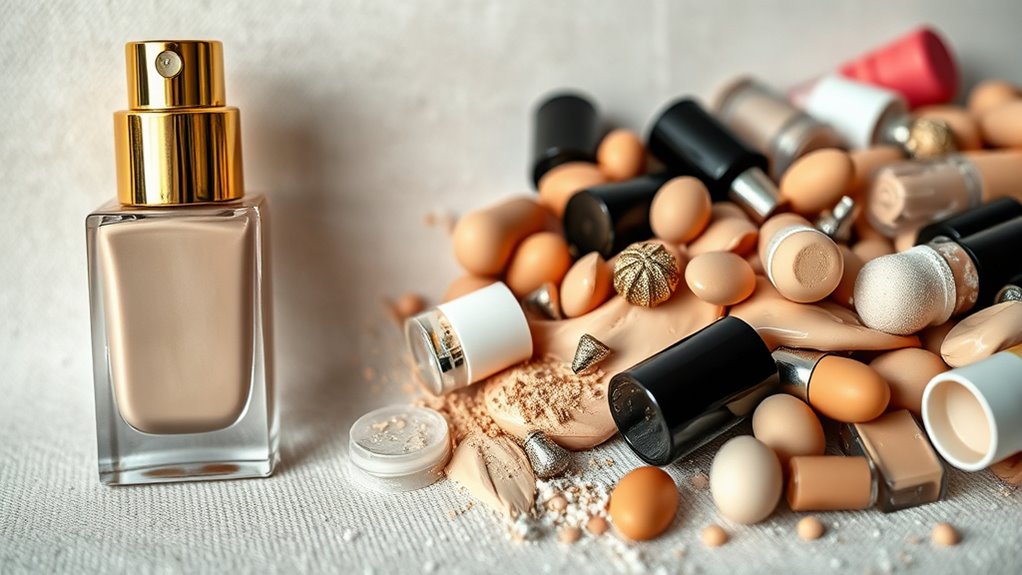
Premium foundations often contain ingredients that can trigger irritation or sensitivities, especially in those with delicate skin. Fragrance is a common culprit, as it can cause contact dermatitis, redness, and allergic reactions. Preservatives like formaldehyde-releasing agents and parabens are also frequent additives in luxury formulas, which may further irritate sensitive skin. Many high-end foundations include complex ingredients like silicones and heavy pigments that can clog pores or worsen sensitivities. Additionally, some exclusive formulations use proprietary or “luxury” additives that lack thorough safety testing, increasing the risk of skin reactions. Higher price tags don’t guarantee safer ingredients—in fact, some luxury foundations harbor more potential irritants than drugstore brands, making them less suitable for sensitive skin.
Cost-Effective Alternatives That Outperform Luxury Options
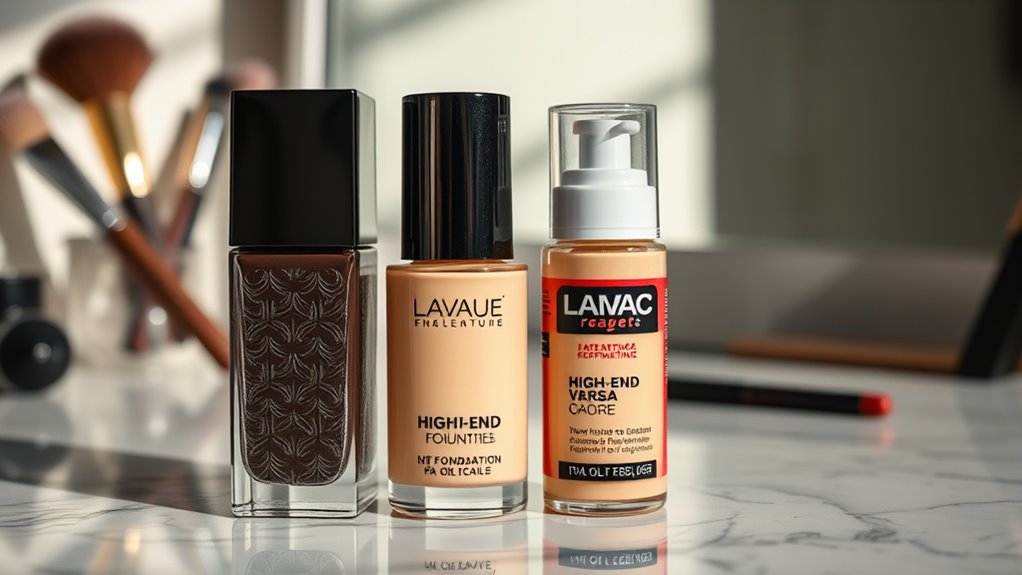
You don’t need to spend a fortune to get a foundation that performs better than luxury brands. Many drugstore options use high-quality ingredients like niacinamide and hyaluronic acid, delivering hydration and improved skin texture. Plus, they offer better coverage, stability, and SPF ratings at a fraction of the cost.
Ingredient Transparency Matters
Ingredient transparency is essential when choosing a foundation, as it helps you identify products that are safer and more effective. Many drugstore brands list their ingredients clearly, avoiding hidden fillers that can cause irritation or reduce performance. This transparency allows you to spot beneficial ingredients like hyaluronic acid, glycerin, and antioxidants, which are often more effective in affordable brands. In contrast, luxury foundations frequently hide proprietary formulas with unlisted components that may not deliver better results.
- Clear ingredient lists help you avoid irritants and allergens
- Affordable brands like Maybelline and e.l.f. include proven active ingredients
- Transparency reveals formulations with effective concentrations of key skincare ingredients
- Sometimes, drugstore brands outperform expensive options due to ingredient clarity and simplicity
Quality at Lower Cost
Many affordable foundations pack high-quality ingredients like niacinamide and hyaluronic acid, often outperforming some luxury options that lack active skin benefits. Drugstore brands like Maybelline and L’Oréal frequently reformulate with better pigments and skin-boosting ingredients, delivering even coverage and lasting wear. The high price of high-end foundations often comes from branding and packaging rather than formulation quality. You’ll find that budget-friendly options can match or beat luxury brands in performance. Here’s a quick comparison:
| Aspect | Drug-Store Foundations | High-End Foundations |
|---|---|---|
| Ingredients | Active skin benefits, antioxidants | Often lacking active ingredients |
| Formulation | Better pigment dispersion, longevity | Sometimes inferior formulation |
| Cost | Affordable, great value | Expensive, branding focus |
You don’t need to overspend to get flawless, long-lasting makeup.
Frequently Asked Questions
What Is the Difference Between Drugstore and High End Foundation?
You might wonder about the difference between drugstore and high-end foundations. While high-end options often come in luxurious packaging and focus on texture and finish, they don’t always perform better on your skin. Both can contain similar ingredients, and quality depends more on formulation and your skin type. Sometimes, drugstore brands offer comparable coverage and longevity at a lower price, making them just as effective for your needs.
Why Is High-End Makeup so Expensive?
You might wonder why high-end makeup costs so much. The main reason is that luxury brands spend heavily on fancy packaging, branding, and marketing rather than on better ingredients or formulas. They often produce their foundations in the same factories as drugstore brands, but charge more for perceived exclusivity and status. So, you’re paying extra for the brand image and packaging, not necessarily for a better-performing product.
Is NYX a High End or Drugstore?
You’re wondering if NYX is high-end or drugstore. NYX is a drugstore brand, meaning it offers affordable makeup available at major retail stores and drugstores. Despite its lower price, NYX delivers trendy, high-quality products with ingredients comparable to more expensive brands. Owned by L’Oréal, NYX targets budget-conscious shoppers who want innovative shades and reliable performance without the high price tag.
Is Maybelline High End or Drugstore?
You might think Maybelline is high-end, but it’s actually a drugstore brand. Visualize a spectrum: on one end, luxury brands with premium packaging and exclusivity; on the other, affordable brands like Maybelline that focus on accessibility and quality. Despite its lower price, Maybelline offers foundations with active ingredients and performance comparable to high-end products, making it a smart choice for effective, budget-friendly makeup.
Conclusion
Remember, higher price doesn’t always mean better quality—you might find drugstore foundations perform just as well or better. Studies show that up to 80% of ingredients in luxury and drugstore brands are similar, so don’t be fooled by fancy packaging. Instead, focus on what works for your skin type and needs. Sometimes, saving money lets you experiment more to find your perfect match, proving that cost doesn’t define beauty or effectiveness.



